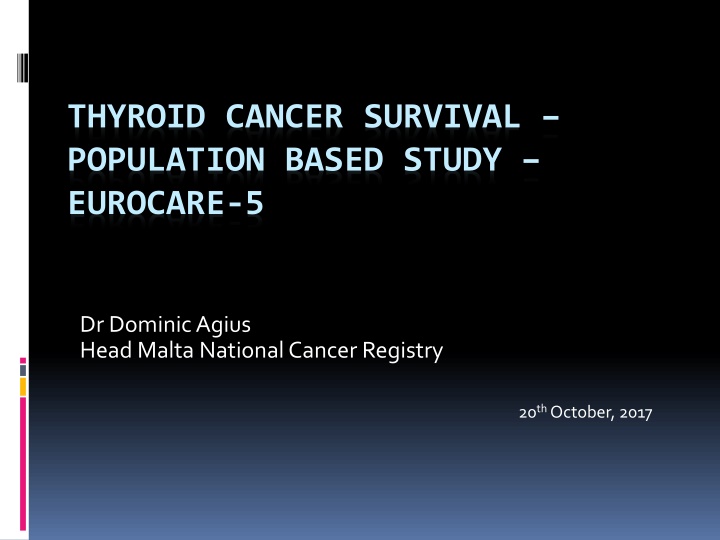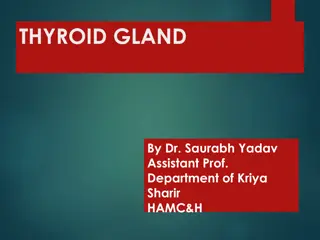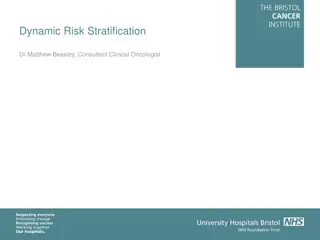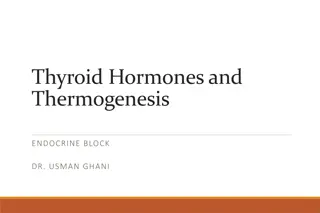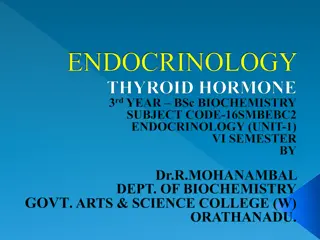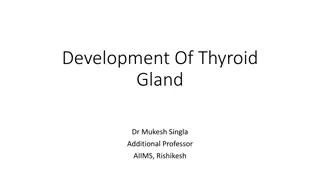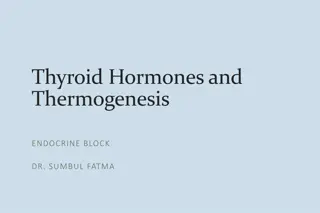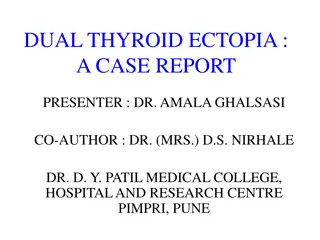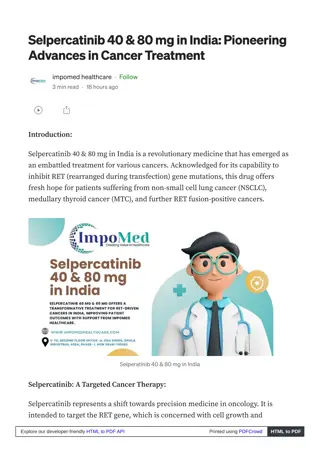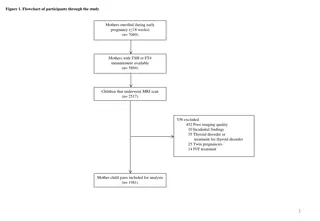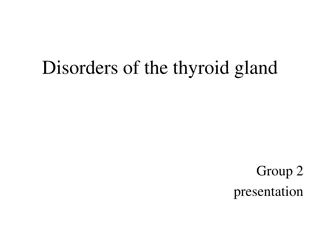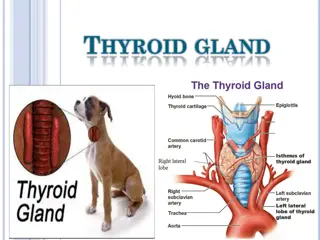Thyroid Cancer Survival Trends in Europe: Eurocare-5 Study
A population-based study on thyroid cancer survival rates in Europe over 25 years reveals insights by sex, country, age, period, and histological type. The study shows increased incidence but stable mortality trends, with varying survival rates based on region, gender, and histology types like papillary, follicular, medullary, and anaplastic. The data from 29 countries sheds light on 1 to 10-year relative survival rates for adult patients diagnosed from 2000 to 2007. Overall, women show higher 5-year relative survival rates compared to men, with papillary type having the highest incidence and survival rates. Additionally, differences in survival rates are observed based on regions in Europe.
Uploaded on Sep 14, 2024 | 1 Views
Download Presentation

Please find below an Image/Link to download the presentation.
The content on the website is provided AS IS for your information and personal use only. It may not be sold, licensed, or shared on other websites without obtaining consent from the author.If you encounter any issues during the download, it is possible that the publisher has removed the file from their server.
You are allowed to download the files provided on this website for personal or commercial use, subject to the condition that they are used lawfully. All files are the property of their respective owners.
The content on the website is provided AS IS for your information and personal use only. It may not be sold, licensed, or shared on other websites without obtaining consent from the author.
E N D
Presentation Transcript
THYROID CANCER SURVIVAL POPULATION BASED STUDY EUROCARE-5 Dr Dominic Agius Head Malta National Cancer Registry 20thOctober, 2017
OVERVIEW Over last 25 years: Relative survival from thyroid cancer by sex, country, age, period and histological type Thyroid cancer incidence increased Mortality trends stable
METHODS Data from 29 countries 1.One and five year Relative Survival Rates for adult patients diagnosed in 2000-2007 and followed-up till end of 2008 2. Trends in Relative Survival Rates in1999- 2007 period 3. 10-year Relative Survival Rates in 2005-2007
RESULTS (INCIDENCE) Overall 5-yr Relative Survival Women 88%; Men 81% Strong correlation by country between survivaland incidence rates and histological type: Highest incidence, survival, papillary type (79%) in Southern Europe. Lowest in UK and Ireland papillary type (58%); Follicular type (23% - 15% in Europe)
RESULTS (INCIDENCE CONT.) 1.0 Age-standardized 5-year relative survival 0.9 0.8 Northern Europe Ireland and UK Central Europe Southern Europe Eastern Europe 0.7 0 5 10 15 20 25 Age-standardized incidence rates per 100,000 Thyroid cancer: Survival Incidence Females
RESULTS (INCIDENCE CONT.) 1.0 Age-standardized 5-year relative survival 0.9 0.8 Northern Europe Ireland and UK Central Europe Southern Europe Eastern Europe 0.7 0 2 4 6 8 10 Age-standardized incidence rates per 100,000 Thyroid cancer: Survival Incidence Men
RESULTS (HISTOLOGY) 5-yr Relative Survival vs histology Papillary (98% in woman; 94% in men) Follicular (92% in women; 87% in men) Medullary (88% in women; 75% in men) Anaplastic (14% in women; 12% in men)
RESULTS (HISTOLOGY) 100% Southern 90% Eastern 80% 5-yr RS Central Nordic 70% UK & Ireland 60% 50% 1999-2001 2002-2004 Period 2005-2007 5-yr RS for papillary thyroid cancer by period and region -women
RESULTS (HISTOLOGY) 100% 90% Nordic Central 80% 5-yr RS Southern 70% UK & Ireland 60% Eastern 50% 1999-2001 2002-2004 Period 2005-2007 5-yr RS for follicular thyroid cancer by period and region women
RESULTS (AGE) Age (yr) Women Men 15-44 >99% 97% 45-54 >95% 90% 55-64 93% 84% 65-74 82% 70% 75+ 57% 51% Thyroid cancer: 5-yr RS by age
RESULTS 10-YR RS 10-yr RS % 10-yr RS conditional on surviving 5 yrs Women 89.4 (88.6-90) 97.5 (96-99) Men 79.2 (77.5-80.7) 94.6 (90.9-98.5) Ten-year relative survival (10-yr RS, %), and 10-year relative survival conditional on surviving five years (10- yr/5-yr)
THYROID CANCER SURVIVAL TRENDS 5-yr RS over period 1999-2007 All thyroid cancers +5% Papillary thyroid cancer +2% Follicular thyroid cancer +4% In women only, medullary and anaplastic cancers +7%
CONCLUSIONS Trends in thyroid cancer survival and country differences seem to be explained by: Varying histological case-mix Age distribution of cases Results could inform management strategies aimed at reducing unnecessary and harmful treatments that negatively impinge on patients quality of life
